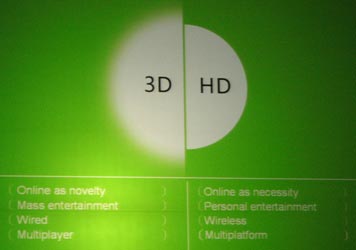GDC: A Theory of Fun
Game Developers Conference. This is a major event in the game industry attracting over 10,000 attendees. Although I wish I had the arms of an octopus for enhanced multi-tasking, I will do my best to provide you with interesting info from the industry. On Monday and Tuesday, there will be posts in regards to the Mobile Game Industry as well as the Serious Games Summit.
First off after the jump: Keynote Speaker Ralph Koster: A Theory of Fun
Ralph Koster, the keynote speaker for the Serious Games Summit (which is about games beyond entertainment), did an hour presentation from his new book A Theory of Fun. He began the presentation with the situation gamers find themselves in when proclaiming for all the world, what they do for a living ó and then the ickiness of having to defend themselves. Although, deep down inside, there’s nothing invalid about it, the outside world continues to perceive gaming as frivolous because of the entertainment value derived from it. However, that value is simply the by-product of human being’s cognitive abilities (or to put it rather crudely, and slightly inadequately, but easily comprehensible, the human ability for pattern recognition). Koster goes on to discuss how pattern making leads to fun. As humans discover patterns, they are rewarded with a pleasant emission to the brain. Games become boring when the patterns are too easy to deduce and when they are difficult because of the inability to draw out a pattern, which is then interpreted as noise. The situations in which game play is most successful, meaning lasts longer than a mere 8 hours of button mashing or clicking, is when other people are involved because the element of competition with another human being allows for various similar yet slightly different pattern solutions. Koster, using the term edutainment, claims that all games provide learning capabilities. In the spirit of the Serious Games Summit, he puts a call out for games that go beyond simple pattern making. There is no gap between entertainment and art games. And that the distinction is the level of intensity and not that they are different types of games. So in order for gamers to no longer feel the need to defend their chosen paths, the medium of games need to be regarded like that of other viable forms of media, such as literature or film in which there are multiple patterns, solutions, and meanings depending on perception and each time it’s experienced.
It was definitely a good motivational start for the Serious Games Summit. During the Q&A, a moved developer posed the question of how to sell these lofty ideals in order to gain investment. Koster’s reply was not to pitch it, but just do it. To not go into game design with all the solutions mapped and planned out which would limit games from being more mature valid forms of media. I fully agree. This sort of approach is not something to pose to another. The idea of proposing it makes it seems as though it were an option, when it is really a next step and should be inherit. As the idea of serious games becomes more prevalent, it will become expected.












